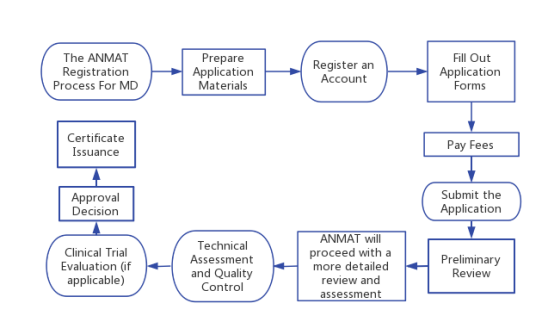Argentina Medical Device Registration Process
I. ANMAT Introduction
In Argentina, the authority responsible for regulating medical devices is the National Administration of Drugs, Foods, and Medical Devices (Administración Nacional de Medicamentos, Alimentos y Tecnología Médica, referred as ANMAT), which operates under the Ministry of Health.
For manufacturers not based in Argentina, it is necessary to appoint a Local Authorized Representative (AAR) in Argentina. The AAR is primarily responsible for handling the submission of medical device registrations and acting as the point of contact with the authorities. They also take care of post-market matters.
II. Regulations.
The regulatory framework for medical device regulation in Argentina includes Resolution 3802/2004, as well as the guidance documents Disposition 4306/99, Disposition 2318/02, Disposition 2319/02, and Disposition 3266/13.
III. Classification of medical devices
Determining the correct classification for your medical device is crucial for ensuring a smooth registration process. Use the 18 rules listed in Annex II of ANMAT's 2318-2002 to determine the classification of your device. ANMAT's classification rules are very similar to the rules in the European Medical Device Directive MDD 93/42/EEC, including Amendment 2007-47-EC.
Classify into four categories based on risk level:
Category | Risk level |
Class I | Low |
Class II | Moderately Low |
Class III | Moderately High |
Class IV | High |
IV. ANMAT Certification information
1. Certificate of Free Sale (CFS) or Certificate to Foreign Government: The CFS or CFG must be provided by a recognized authority in a country that has an agreement with ANMAT. This agreement holds information about medical devices and their applicable accessories, as well as the manufacturer's name.
2. Commercial History
3. Technical Documentation in Spanish: All documents submitted to ANMAT must be in Spanish. Additionally, files submitted to ANMAT must include information on device classification, instructions for use (IFU), labeling, manufacturer details, and technical documentation.
4. Payment Certification of Registration Fees
5. Mercosur Compliance Declaration
6. Affidavit of Reportable Recall and Field Safety Corrective Action
Note: For Class I devices, the AAR only needs to submit payment certification, manufacturer information, and the Mercosur Compliance Declaration.
V. System assessment
1. The quality system requirements in Argentina are very similar to the U.S. FDA 21 CFR Part 820. Our consultants will give you some advice on what modifications need to be made to your existing quality system to prepare for ANMAT quality system certification audits.
2. ANMAT requires a Certificate of Free Sale (CFS) from recognized countries (Australia, Canada, Japan, the United States, and the European Union). If the devices do not have a CFS from a recognized country, a Good Manufacturing Practices (GMP) certificate is needed, which is similar to ISO 13485 and QSR.
Note: All implants, intrauterine devices, and blood bags require risk management according to ISO 14971.
3. ANMAT certificate validity period: 5 years.
4. ANMAT registration cycle: 1-12 months.
5. MERCOSUR Common External Tariff (El Arancel Externo Commr, AEC): All imported medical devices are subject to taxation under the AEC. The tax rates vary depending on whether the products are refurbished (0%-24%) or non-refurbished (0%-16%).
6. Value Added Tax (VAT): VAT should be paid when purchasing medical devices. The extent of the VAT depends on the insurance, cost and freight (CIF) value of the product.
7. Audit time and validity period: The standard audit time for submissions is 180 days. However, in general, Class I medical devices are reviewed within 30-60 days, while all other devices may take up to one year. If the product is approved, it is valid for 5 years in the Argentine market.
VI. ANMAT Registration process of medical devices
1. Prepare Application Information: Depending on your product type, prepare all necessary application documents and materials, including but not limited to product description, ingredients, quality controls, clinical trial results (if applicable), manufacturing processes, etc.
2. Register an Account: Register an account on the ANMAT official website, which will allow you to submit your application and communicate with ANMAT online.
3. Fill Out Application Forms: Log in with your registered account and complete the relevant application forms, providing product-related information and required documents.
4. Pay Fees: Pay the appropriate registration fees based on your application type and product category.
5. Submit the Application: Submit the application form and relevant documents online.
6. Initial Review: ANMAT will conduct a initial review of your application to ensure that all necessary information has been provided and meets the requirements.
7. Detailed Review and Assessment: If your initial review is successful, ANMAT will conduct a more detailed review and assessment. This may involve a thorough examination of the documents, and ANMAT may request additional information or engage in further communication.
8. Technical Assessment and Quality Control: ANMAT may conduct a technical assessment and quality control audit of declared product to ensure compliance with relevant regulations and standards.
9. Clinical Trial Evaluation (if applicable): If your product requires clinical trials, ANMAT will evaluate the trial results to ensure the safety and efficacy of the product.
10. Approval Decision: Based on the audit results, ANMAT will make a decision to approve or reject your application. If your application is approved, you will receive a registration certificate or approval letter.
11. Registration Certificate Issuance: If approved, you will receive a registration certificate issued by ANMAT, allowing you to sell your product in the Argentine market.
12. Regulation and Updates: Once registered, you must continue to comply with ANMAT's regulatory requirements and renew or update the registration as needed.



